
Cactus on the back porch on 9-22-21, #833-2.
Hello everyone! I hope this post finds you well. It has been a strange fall for sure. I was able to let the potted plants stay outside until October 28 this year. While we did have a cold snap and a few light “F’s’, low’s through Wednesday will be 46-54° F. After that we go downhill again. If I wanted, and no one was looking, I could take the plants back outside again until Thursday… Well, maybe that wouldn’t be a good idea since it could rain.
I forgot to take a group photo of the cactus on the back porch before I brought them inside. It was kind of rainy and I was in a bit of a hurry. The Alocasia and Bilbergia nutans (Queen’s Tears) went to the basement and the other plants went on shelves. I already posted about them and was leaving the cactus until last. I already posted about the cactus on the front porch, which leaves those that are on the back porch.
Here we go in alphabetical order…
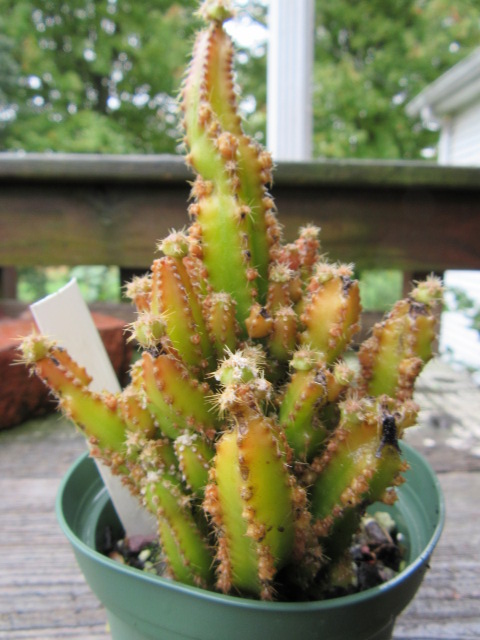
Acanthocereus tetragonus (Fairytale Cactus) at 5″ tall x 2 3/4″ wide on 10-28-21, #853-1.
The Acanthocereus tetragonus did very well over the summer and grew to 5″ tall and is still 2 3/4″ wide. It probably would have grown taller but apparently, the top of the tallest stem broke off… Even at that, it is 3/4″ taller than when it was last measured on October 15 in 2020. It was 3″ tall when I brought it home from Wagler’s Greenhouse on October 18 in 2018. Mrs. Wagler had two HUGE plants but she said one disappeared… Likely out the other door when no one was around… Her plants of this species always look much better than this one because they aren’t outside in the elements.
<<<<+>>>>
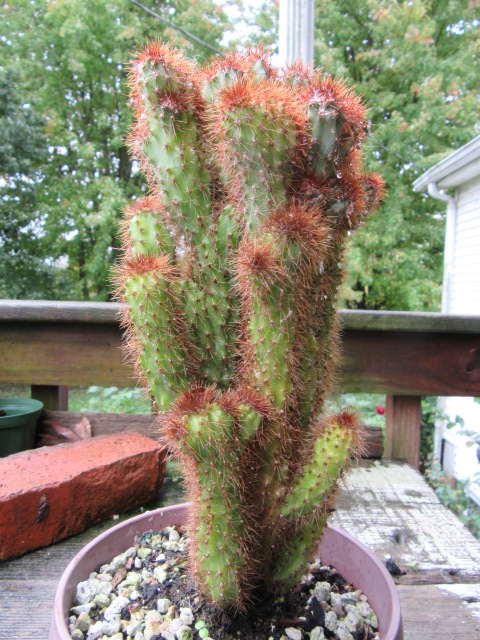
Cereus repandus f. monstruosus ‘Rojo’ at 9 3/4″ tall x 4 3/4″ wide on 10-28-21, #853-2.
The Cereus repandus f. monstruosus ‘Rojo’ grew another 1 1/2″ taller to 9 3/4″ and 1/2″ wider. It was 5 1/2″ tall when I brought it home from Wal-Mart on March 19 in 2018.
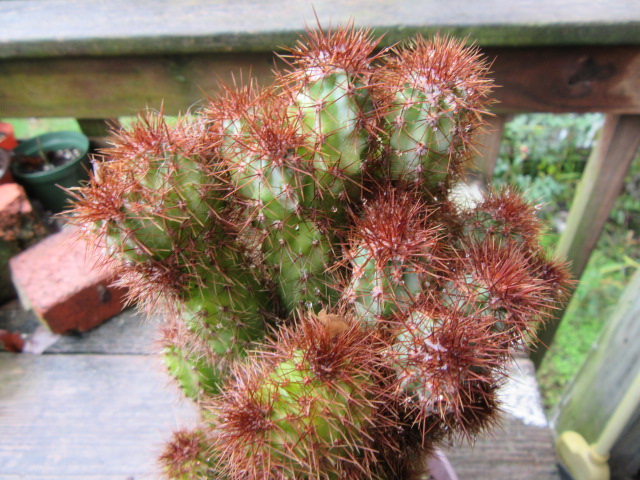
Cereus repandus f. monstruosus ‘Rojo’ from the top on 10-28-21, #853-3.
Always a neat plant from any angle… I have had absolutely no issues with this plant.
<<<<+>>>>

Echinopsis ‘Rainbow Bursts’ at 4″ tall x 7 1/2″ wide on 10-28-21, #853-4.
The Echinopsis ‘Rainbow Bursts’ continues to do well and is STILL 4″ tall but has spread out another 1/2″ over the summer. STILL waiting for flowers… The cluster was 2 1/4″ tall x 3 1/2″ wide when I brought it home from Wal-Mart on February 1 in 2016. Back then it was called x Echinobivia ‘Rainbow Bursts’ and was a hybrid between Echinopsis and Lobivia… The Lobivia genus became a synonym of Echinopsis and its species were moved here and there. There were a few other genera that became synonyms of Echinopsis at the time.
The wife of one of my cousins has several old and LARGE clusters of Echinopsis that put on quite a show every year.
<<<<+>>>>

Echinopsis huascha (var. grandiflora)(Desert’s Blooming Jewel) at 5″ tall x 2 1/4″ wide on 10-28-21, #853-5.
What can I say? I am not sure why this particular Echinopsis huascha (var. grandiflora (Desert’s Blooming Jewel) has this fungal disease (or whatever it is). The six in the other pot are just fine and have been treated the same. It is A LOT worse than before. It is supposed to be caused by overwatering in cool temps. Any cactus can have this issue and Echinopsis are no more susceptible than any other. Even so, this plant has grown to 5″ tall over the summer. It was 3 7/8″ tall last October 15 and 3″ tall when I brought it home from Lowe’s on September 21 in 2018.
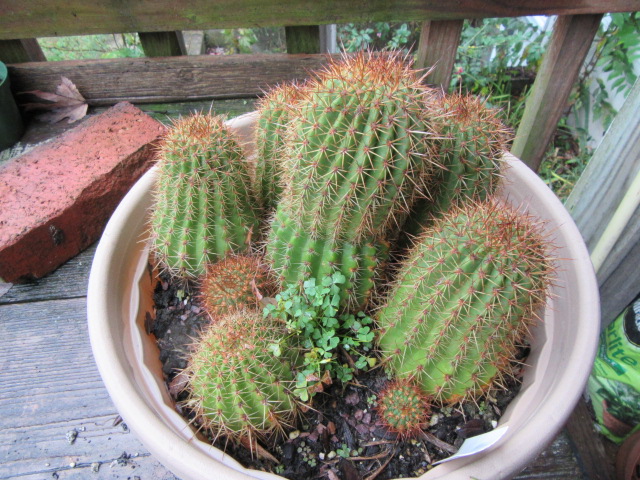
Echinopsis huascha (var. grandiflora) (Desert’s Blooming Jewel). The largest plant in the center of the pot was 6 3/4″ tall x 3″ wide on 10-28-21, #853-6.
As you can see, the six in this pot are doing just fine and sending out offsets. The largest plant in the center of the pot was 6 3/8″ tall x 3″ wide. SOOO, it either shrunk or I mismeasured it last October… 🙂 The tallest plant in the center was only 3″ tall when I brought them home from Lowe’s on November 29 in 2018. Yes, the same day as the single plant because I goofed. Well, there was a pot of seven cactus in a pot that was on clearance because a bigger plant in the middle of the pot was dead. I repotted them and they have done great! I didn’t notice at the time the label in the pot said Trichocereus grandiflorus like the smaller plant I already had in my cart. If the one with issues doesn’t make it, I still have a pot of six plus the offsets.
The Echinopsis huascha is one of “those” controversial species that hails from Argentina. It has been in multiple genera with many species names becoming synonyms of Echinopsis huascha. When I last updated this plants page last December, Plants of the World Online listed 43 synonyms. They are updating their synonyms so if you happen to check on POWO now they currently list only five… So, I didn’t update the synonyms. Even so, no other database lists 43 synonyms of this species. The other problem with this species is that it is variable in growth, shape, size, spine length and color, flower color, etc. Even so, there is only one accepted infraspecific name. LLIFLE (and other websites) list the particular plants I have as Echinopsis huascha var. grandiflora. That name was invalidly published and somehow isn’t even listed on the International Plant Names Index as an invalid name… SO, I just put var. grandiflora in parenthesis. It isn’t legit. 🙂
<<<<+>>>>
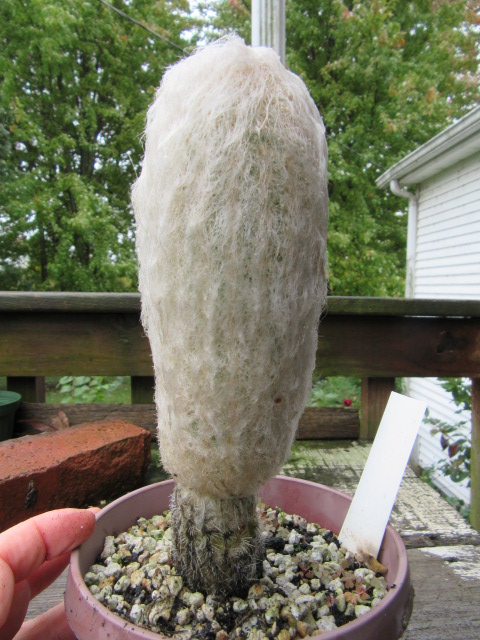
Espostoa melanostele subsp. nana (Peruvian Old Lady) at 8 1/2″ tall x 2 1/2″ wide on 10-28-21, #853-7.
The Espostoa melanostele subsp. nana (Peruvian Old Lady) seems to have shrunk 1/2″ to 8 1/2″ and is still 2 1/2″ wide. Well, that’s OK since it seems perfectly happy and healthy. I guess it took a break since it has grown from 2 3/4″ when I brought it home from Wal-Mart on February 1 in 2016. The subspecies name is legit with this one… 🙂
<<<<+>>>>
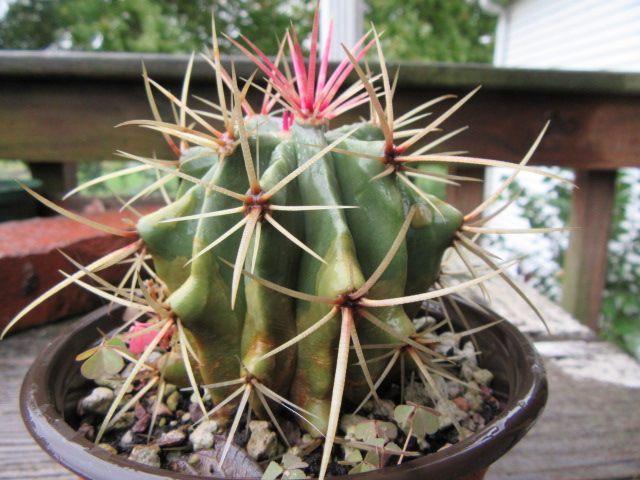
Ferocactus wislizeni (Fishhook Barrel Cactus) at 2 1/2′ tall x 3″ wide on 10-28-21, #853-8.
The Ferocactus wislizeni (Fishhook Barrel Cactus) is a slow grower. It now measured 2 1/2′ tall x 3″ wide on the 28th which is 1/8″ taller than last year. It was only 1 5/8″ tall x 2 1/8″ wide when I brought it home from Lowe’s on March 29 in 2019. I like the way its new bristles are a bright red. It doesn’t seem to be looking its best, though. I brought home a Ferocactus latispinus in 2016 but it didn’t live very long…
Information online says these plants need plenty of water during their active growth cycle but not to get their “bodies” wet while in direct sunlight. LLIFLE says, “A wet cactus in the sunlight can cause sun burning which can lead to scars or even fungal infections and death.” Well, I never water any of my plants when the sun is on them… What is a person supposed to do If it rains in the morning and the sun comes out in the afternoon?
<<<<+>>>>
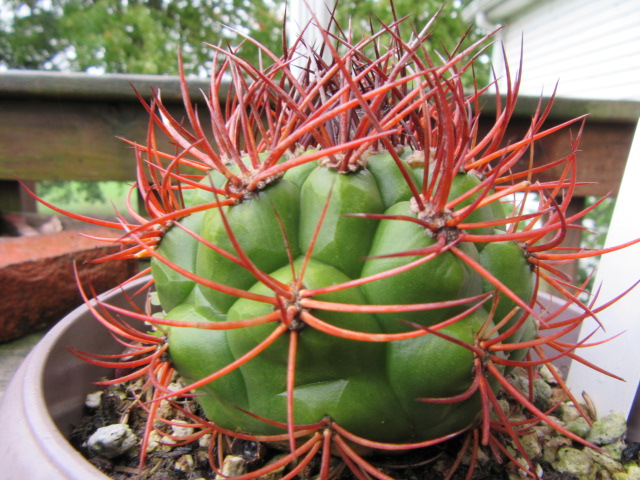
Gymnocalycium saglionis (Giant Chin Cactus) at 2 3/8″ tall x 3 1/2″ wide on 10-28-21, #853-9.
Hmmm… I need to take new photos of this one because its spines are definitely not red or that bright of green! Anyway, the Gymnocalycium saglionis (Giant Chin Cactus) did great over the summer and grew 3/8″ taller to 2 3/8″ wide x 3 1/2″ wide. I really like this plant.
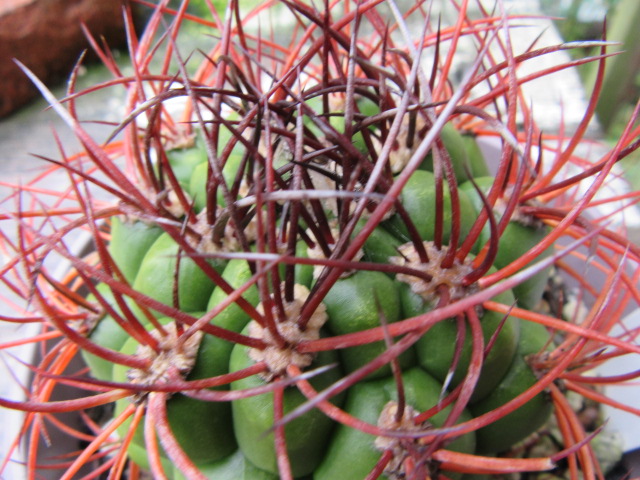
Gymnocalycium saglionis (Giant Chin Cactus) from the top on 10-28-21, #853-10.
The G. saglionis has been a great plant and it has no issues… Not a single blemish anywhere. I just have to have a talk with it when I take new photos… Well, I read where the spines are red when they are wet. While, yes, the cactus were wet when I took their photos on the 28th, this plant’s spines only looked red in the photo… There are photos online of this species with red spines because they are wet. 🙂
I really like this cactus and was glad to find a Gymnocalycium baldianum (Dwarf Chin Cactus) at Wal-Mart on December 2, 2020. It died over the summer…
<<<<+>>>>
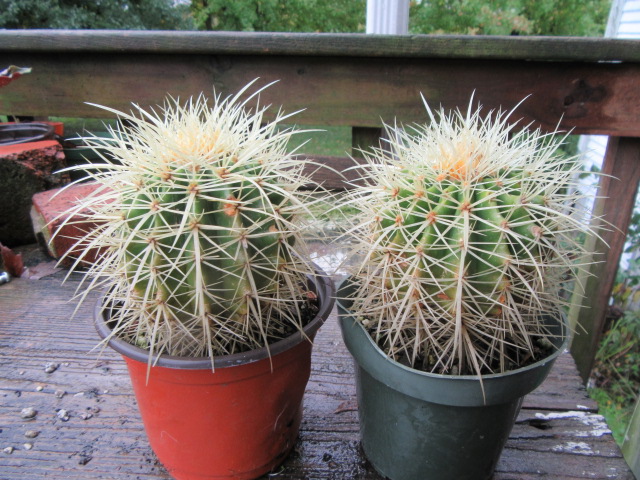
Kroenleinia grusonii (Golden Barrel Cactus). Lessor (left) at 3 3/8″ tall x 3 1/4″ wide and Greater (right) at 3 5/8″ tall x 3″ wide on 10-28-21, #853-11.
The two Kroenleinia grusonii (Golden Barrel Cactus) are still the jokers of the bunch. Last October they were the same size at 3 1/2″ tall x 2 3/4″ wide. This time, Greater grew to 3 5/8″ tall x 3″ wide, and Lessor was 3 3/8′ tall x 3 1/4″ wide. I measured several times because they like to fool me and I am sure Lessor was wiggling… I still thought something was off with the measurements as I wrote this so I thought I would get them off the shelf and do it again. As I reached for Lessor, Greater smiled. I thought, “GEEZ! I have been suckered again”. I sat back down then thought I would call their bluff. So, I got back up and took Lessor from the shelf and measured him AGAIN. Sure enough, he was 3 3/8″ tall, give or take a hair, but I couldn’t see him being 3 1/4″ wide. Then, all the sudden he was 3 1/4″ wide. They have done very well despite their issues with crickets scarring them a few years ago and a blemish here and there. Lessor was 2 1/8″ tall x 2 1/4″ wide and Greater was 2 1/2″ tall x 2″ wide when I brought them home from Wal-Mart February 1 in 2016. They have fooled me several times over the years since I accidentally brought two home instead of just one.
Kroenleinia grusonii WAS Echinocactus grusonii from 1886 until 2014 when testing proved the species was more closely related to the genus Ferocactus. SO, they changed the name to Kroenleinia grusonii and now it is in a genus of its very own… all by itself. It always takes a few (to several) years for the new names to be officially approved. Kroenleinia is MUCH harder to spell and I STILL haven’t found the pronunciation… Dave’s Garden is behind…
Well, I think I will stop here and start working on part 2. I don’t want to put too many on the same post.
Until next time, take care and always be thankful!













